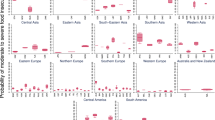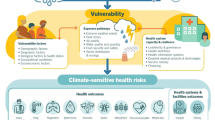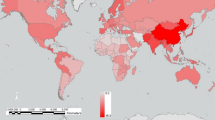Abstract
Climate change is expected to increase the frequency, intensity and spatial extent of extreme climate events, and thus is a key concern for food production. However, food insecurity is usually analysed under a mean climate change state. Here we combine crop modelling and climate scenarios to estimate the effects of extreme climate events on future food insecurity. Relative to median-level climate change, we find that an additional 20–36% and 11–33% population may face hunger by 2050 under a once-per-100-yr extreme climate event under high and low emission scenarios, respectively. In some affected regions, such as South Asia, the amount of food required to offset such an effect is triple the region’s current food reserves. Better-targeted food reserves and other adaptation measures could help fill the consumption gap in the face of extreme climate variability.
This is a preview of subscription content, access via your institution
Access options
Access Nature and 54 other Nature Portfolio journals
Get Nature+, our best-value online-access subscription
$29.99 / 30 days
cancel any time
Subscribe to this journal
Receive 12 digital issues and online access to articles
$119.00 per year
only $9.92 per issue
Buy this article
- Purchase on SpringerLink
- Instant access to full article PDF
Prices may be subject to local taxes which are calculated during checkout




Similar content being viewed by others
Data availability
The data used in the study are available at the Harvard Dataverse Repository: https://doi.org/10.7910/DVN/KW2UEP
Code availability
The code used in the study is available at the Harvard Dataverse Repository: https://doi.org/10.7910/DVN/KW2UEP
References
Handmer, J. et al. in Managing the Risks of Extreme Events and Disasters to Advance Climate Change Adaptation, (eds Field, C. B. et al.) 231–290 (Cambridge Univ. Press, 2012).
Tao, F. & Zhang, Z. Climate change, high-temperature stress, rice productivity, and water use in eastern China: a new superensemble-based probabilistic projection. J. Appl. Meteorol. Climatol. 52, 531–551 (2013).
Challinor, A. J., Simelton, E. S., Fraser, E. D. G., Hemming, D. & Collins, M. Increased crop failure due to climate change: assessing adaptation options using models and socio-economic data for wheat in China. Environ. Res. Lett. 5, 034012 (2010).
Urban, D., Roberts, M. J., Schlenker, W. & Lobell, D. B. Projected temperature changes indicate significant increase in interannual variability of US maize yields. Clim. Change 112, 525–533 (2012).
Müller, C. & Robertson, R. D. Projecting future crop productivity for global economic modeling. Agric. Econ. 45, 37–50 (2014).
Nelson, G. C. et al. Climate change effects on agriculture: economic responses to biophysical shocks. Proc. Natl Acad. Sci. USA 111, 3274–3279 (2014).
Rosenzweig, C. & Parry, M. L. Potential impact of climate change on world food supply. Nature 367, 133–138 (1994).
Fischer, G., Shah, M., N. Tubiello, F. & van Velhuizen, H. Socio-economic and climate change impacts on agriculture: an integrated assessment, 1990–2080. Philos. Trans. R. Soc. B Biol. Sci. 360, 2067–2083 (2005).
Nelson, G. C. et al. Food Security, Farming, and Climate Change to 2050, Scenarios, Results, Policy Options (IFPRI, 2010).
Hasegawa, T. et al. Climate Change impact and adaptation assessment on food consumption utilizing a new scenario framework. Environ. Sci. Technol. 48, 438–445 (2014).
Stevanovic, M. et al. The impact of high-end climate change on agricultural welfare. Sci. Adv. 2, e1501452 (2016).
Lobell, D. B. et al. Prioritizing climate change adaptation needs for food security in 2030. Science 319, 607–610 (2008).
Fuss, S. et al. Global food security & adaptation under crop yield volatility. Technol. Forecast. Soc. Change 98, 223–233 (2015).
Diffenbaugh, N. S., Hertel, T. W., Scherer, M. & Verma, M. Response of corn markets to climate volatility under alternative energy futures. Nat. Clim. Chang. 2, 514–518 (2012).
Ahmed, A. S., Diffenbaugh, S. N. & Hertel, W. T. Climate volatility deepens poverty vulnerability in developing countries. Environ. Res. Lett. 4, 034004 (2009).
Ahmed, S. A. et al. Climate volatility and poverty vulnerability in Tanzania. Glob. Environ. Change 21, 46–55 (2011).
Suweis, S., Carr, J. A., Maritan, A., Rinaldo, A. & D’Odorico, P. Resilience and reactivity of global food security. Proc. Natl Acad. Sci. USA 112, 6902–6907 (2015).
Puma, M. J., Bose, S., Chon, S. Y. & Cook, B. I. Assessing the evolving fragility of the global food system. Environ. Res. Lett. 10, 024007 (2015).
Chatzopoulos, T., Perez Dominguez, I., Zampieri, M. & Toreti, A. Climate extremes and agricultural commodity markets: a global economic analysis of regionally simulated events. Weather Clim. Extrem. 27, 100193 (2019).
Katz, R. W. & Brown, B. G. Extreme events in a changing climate: variability is more important than averages. Clim. Change 21, 289–302 (1992).
Salinger, M. J. Climate variability and change: past, present and future–an overview. Clim. Change 70, 9–29 (2005).
Flato, G. et al. in Climate Change 2013: The Physical Science Basis (eds Stocker, T. F. et al.), 741–866 (Cambridge University Press, 2013).
The State of Food Insecurity in the World 2012: Economic Growth Is Necessary but Not Sufficient to Accelerate Reduction of Hunger and Malnutrition (Food and Agriculture Organization, 2012).
Hasegawa, T. et al. Consequence of climate mitigation on the risk of hunger. Environ. Sci. Technol. 49, 7245–7253 (2015).
Sakurai, G., Iizumi, T., Nishimori, M. & Yokozawa, M. How much has the increase in atmospheric CO2 directly affected past soybean production? Sci. Rep. 4, 4978 (2014).
Müller, C. et al. The global gridded crop model intercomparison phase 1 simulation dataset. Sci. Data 6, 50 (2019).
Fujimori, S., Masui, T. and Matsuoka, Y. AIM/CGE [Basic] Manual (Center for Social and Environmental Systems Research, NIES, 2012).
Sillmann, J. et al. Understanding, modeling and predicting weather and climate extremes: challenges and opportunities. Weather Clim. Extrem. 18, 65–74 (2017).
Attribution of Extreme Weather Events in the Context of Climate Change (National Academies Press, 2016).
Stephenson, D. B. in Climate Extremes and Society (eds Diaz H. F. & Murnane R. J.) 11–23 (Cambridge University Press, 2008).
Hasegawa, T., Fujimori, S., Takahashi, K. & Masui, T. Scenarios for the risk of hunger in the twenty-first century using shared socioeconomic pathways. Environ. Res. Lett. 10, 014010 (2015).
Fujimori, S. et al. A multi-model assessment of food security implications of climate change mitigation. Nat. Sustain. 2, 386–396 (2019).
van Meijl, H., Tabeau, A., Stehfest, E., Doelman, J. & Lucas, P. How food secure are the green, rocky and middle roads: food security effects in different world development paths. Environ. Res. Commun. 2, 031002 (2020).
van Vuuren, D. P. et al. The representative concentration pathways: an overview. Clim. Change 109, 5–31 (2011).
Hasegawa, T. et al. Risk of increased food insecurity under stringent global climate change mitigation policy. Nat. Clim. Chang. 8, 699–703 (2018).
Lassa, J. A., Teng, P., Caballero-Anthony, M. & Shrestha, M. Revisiting emergency food reserve policy and practice under disaster and extreme climate events. Int. J. Disaster Risk Sci. 10, 1–13 (2019).
Janssens, C. et al. Global hunger and climate change adaptation through international trade. Nat. Clim. Chang. 10, 829–835 (2020).
International Assessment of Agricultural Knowledge: Science and Technology for Development Global Report (IAASTD, 2009).
Stathers, T., Lamboll, R. & Mvumi, B. M. Postharvest agriculture in changing climates: its importance to African smallholder farmers. Food Sec. 5, 361–392 (2013).
Chriest, A. & Niles, M. The role of community social capital for food security following an extreme weather event. J. Rural Stud. 64, 80–90 (2018).
World Agricultural Supply and Demand Estimates Report (US Department of Agriculture, 2016).
O’Neill, B. C. et al. A new scenario framework for climate change research: the concept of shared socioeconomic pathways. Clim. Change 122, 387–400 (2014).
Riahi, K. et al. The Shared Socioeconomic Pathways and their energy, land use, and greenhouse gas emissions implications: an overview. Global Environ. Change 42, 153–168 (2017).
Fujimori, S. et al. SSP3: AIM implementation of Shared Socioeconomic Pathways. Global Environ. Change 42, 268–283 (2017).
Masutomi, Y., Takahashi, K., Harasawa, H. & Matsuoka, Y. Impact assessment of climate change on rice production in Asia in comprehensive consideration of process/parameter uncertainty in general circulation models. Agric. Ecosyst. Environ. 131, 281–291 (2009).
Denman, K. L. et al. Couplings Between Changes in the Climate System and Biogeochemistry (Cambridge University Press, 2007).
Lal, P. N. et al. in Managing the Risks of Extreme Events and Disasters to Advance Climate Change Adaptation, [Field, C.B. et al. (eds.)]. 339–392 (Cambridge University Press, 2012).
Hertel, T. W. Food security under climate change. Nat. Clim. Chang. 6, 10–13 (2016).
O’Neill, B. C. et al. Achievements and needs for the climate change scenario framework. Nat. Clim. Chang. 10, 1074–1084 (2020).
Adoption of the Paris Agreement FCCC/CP/2015/L.9/Rev.1 (UNFCCC, 2015) http://unfccc.int/resource/docs/2015/cop21/eng/10a01.pdf
Taylor, K. E., Stouffer, R. J. & Meehl, G. A. An overview of CMIP5 and the experiment design. Bull. Am. Meteorol. Soc. 93, 485–498 (2011).
Hempel, S.F., Frieler, K., Warszawski, L., Schewe, J. & Piontek, F. Bias Corrected GCM Input Data for ISIMIP Fast Track (GFZ Data Services, 2013).
Iizumi, T., Takikawa, H., Hirabayashi, Y., Hanasaki, N. & Nishimori, M. Contributions of different bias-correction methods and reference meteorological forcing data sets to uncertainty in projected temperature and precipitation extremes. J. Geophys. Res. Atmos. 122, 7800–7819 (2017).
Iizumi, T. et al. Prediction of seasonal climate-induced variations in global food production. Nat. Clim. Chang. 3, 904–908 (2013).
Parry, M., Rosenzweig, C., Iglesias, A., Fischer, G. & Livermore, M. Climate change and world food security: a new assessment. Global Environ. Change 9, S51–S67 (1999).
Mastrandrea, M. D. et al. Guidance Note for Lead Authors of the IPCC Fifth Assessment Report on Consistent Treatment of Uncertainties (IPCC, 2010).
Zhou, D., Yu, X. & Herzfeld, T. Dynamic Food Demand in Urban China. GlobalFood Discussion Paper (Georg-August-Universität Göttingen, 2014).
Bhargava, A. Estimating short and long run income elasticities of foods and nutrients for rural south India. J. R. Stat. Soc. Ser. A Stat. Soc. 154, 157–174 (1991).
Farquhar, G. D., von Caemmerer, S. & Berry, J. A. A biochemical model of photosynthetic CO2 assimilation in leaves of C3 species. Planta 149, 78–90 (1980).
Neitsch, S. L., Arnold, J. G., Kiniry, J. R., Williams, J. R. & King, K. W. Soil and Water Assessment Tool Theoretical Documentation (Grassland Soil and Water Research Laboratory, Agricultural Research Service, United States Department of Agriculture, 2009).
Iizumi, T. et al. Historical changes in global yields: major cereal and legume crops from 1982 to 2006. Glob. Ecol. Biogeogr. 23, 346–357 (2014).
Vrugt J. A. A. H., et al. Accelerating Markov chain Monte Carlo simulation by differential evolution with self-adaptive randomized subspace sampling. Int. J. Nonlinear Sci. Numer. Simul. 10 (2009).
Baldocchi, D. An analytical solution for coupled leaf photosynthesis and stomatal conductance models. Tree Physiol. 14, 1069–1079 (1994).
Fujimori, S., Hasegawa, T., Masui, T. & Takahashi, K. Land use representation in a global CGE model for long-term simulation: CET vs. logit functions. Food Sec. 6, 685–699 (2014).
von Lampe, M. et al. Why do global long-term scenarios for agriculture differ? An overview of the AgMIP global economic model intercomparison. Agric. Econ. 45, 3–20 (2014).
Hanasaki, N. et al. A global water scarcity assessment under Shared Socio-economic Pathways—part 1: water use. Hydrol. Earth Syst. Sci. 17, 2375–2391 (2013).
FAO Methodology for the Measurement of Food Deprivation: Updating the Minimum Dietary Energy Requirements (Food and Agriculture Organization, 2008).
Acknowledgements
This work was supported by the Environment Research and Technology Development Fund (JPMEERF20202002, JPMEERF20211001 and JPMEERF20182001) of the Environmental Restoration and Conservation Agency of Japan, Sumitomo Foundation and the Ritsumeikan Global Innovation Research Organization (R-GIRO), Ritsumeikan University.
Author information
Authors and Affiliations
Contributions
T.H., G.S., S.F., K.T. and T.M. designed the research. T.H. created figures and wrote the draft of the paper. G.S. performed the crop model experiments. T.H. and S.F. performed the economic model experiments and analysed the data. All authors discussed the results. T.H., G.S., S.F., K.T. and Y.H. contributed to writing the paper.
Corresponding author
Ethics declarations
Competing interests
The authors declare no competing interests.
Additional information
Peer review information Nature Food thanks the anonymous reviewers for their contribution to the peer review of this work.
Publisher’s note Springer Nature remains neutral with regard to jurisdictional claims in published maps and institutional affiliations.
Supplementary information
Supplementary Information
Supplementary Notes 1–10, Figs. 1–17, Tables 1–5 and References.
Rights and permissions
About this article
Cite this article
Hasegawa, T., Sakurai, G., Fujimori, S. et al. Extreme climate events increase risk of global food insecurity and adaptation needs. Nat Food 2, 587–595 (2021). https://doi.org/10.1038/s43016-021-00335-4
Received:
Accepted:
Published:
Issue Date:
DOI: https://doi.org/10.1038/s43016-021-00335-4
This article is cited by
-
Key predictors of food security and nutrition in Africa: a spatio-temporal model-based study
BMC Public Health (2024)
-
Climate change mitigation and adaptation for rice-based farming systems in the Red River Delta, Vietnam
CABI Agriculture and Bioscience (2024)
-
A cost-effective climate mitigation pathway for China with co-benefits for sustainability
Nature Communications (2024)
-
Intensifying rice production to reduce imports and land conversion in Africa
Nature Communications (2024)
-
Compound and cascading droughts and heatwaves decrease maize yields by nearly half in Sinaloa, Mexico
npj Natural Hazards (2024)



